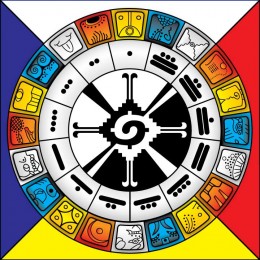 “Our modern day astrophysicists and astronomers, with all their sophisticated scientific instruments, are not the only humans that have wondered what may exist at the center of our galaxy. The superb astronomers and mathematicians of the ancient Mayan civilization, also pondered this question. The Mayans knew where in the sky the exact center of the galaxy was located and they even had a glyph representing it which is now named Hunab Ku ; it was known to the Mayans as The Galactic Butterfly. Their entire cosmology and extremely accurate calendars were based on the existence and location of Hunab Ku and they deeply believed that the future of mankind ultimately depends on what occurs there.” – John Ennis
“Our modern day astrophysicists and astronomers, with all their sophisticated scientific instruments, are not the only humans that have wondered what may exist at the center of our galaxy. The superb astronomers and mathematicians of the ancient Mayan civilization, also pondered this question. The Mayans knew where in the sky the exact center of the galaxy was located and they even had a glyph representing it which is now named Hunab Ku ; it was known to the Mayans as The Galactic Butterfly. Their entire cosmology and extremely accurate calendars were based on the existence and location of Hunab Ku and they deeply believed that the future of mankind ultimately depends on what occurs there.” – John Ennis
Hunab Ku was, to the Mayans, the supreme God and ultimate Creator and was located in the center of the Milky Way galaxy. It represented the gateway to other galaxies beyond our Sun as well as all of the consciousness that has ever existed in this, our own galaxy. Hunab Ku, according to the Mayans, is also the consciousness which organized all matter from a whirling disk – into stars, planets and solar systems. Hunab Ku is the Mother Womb which is constantly giving birth to new stars and it gave birth to our own Sun and planet Earth as well as the other planets found in our solar system. They also believed that the ultimate Creator directs everything that happens in our galaxy from its center through the emanation of periodic energy bursts of consciousness.
Today, modern astronomers have indeed verified that at the center of our Milky Way galaxy is found a “whirling disk” with a “Black Hole” at its center that is both swallowing and giving birth to stars. Could the extraordinary low frequency radio wave images discovered coming from the center of our Milky Way galaxy be programmed bursts of energy consciousness coming from the ultimate Creator… and actually be a modern manifestation of what the ancient Mayans believed? […]
From: Sun-Nation

 RSS FEED
RSS FEED FACEBOOK
FACEBOOK TWIITER
TWIITER TUMBLR
TUMBLR